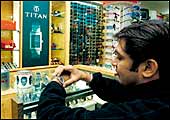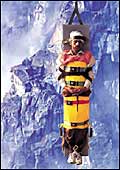|
It's
all about attitude! your bag, your jewellery, your t-shirt, all
are about sporting your attitude. Circa 2004, attitude defines a
brand. And design creates attitude (think iMac, Alienworks, Hugo
Boss). Design is about style, ease of use, new materials and colours;
different combinations of these create new products. Design can
also mean lower costs, perhaps, versatility in use. However you
see it, until recently, no one in their right minds spoke of design
and India in the same breath. Indian designers either headed Westwards
(think Anand Jon) or morphed into lone rangers working on one-off
projects. Those that managed to secure employment in companies were
put to work on reverse engineering products or simply tinkering
with designs inspired (read borrowed) from companies and designers
elsewhere in the world. Today, all that is beginning to change.
"The idea is to pick up nascent
trends from street fashion," says Michael Foley, the head designer
of Titan's Fastrack range. "Fastrack is targeted at people who are
experimental, aware of trends, fashionable and not skewed towards
a global brand. Our boys' fashions pick up roots from music, sports,
formula one and technology; girls' fashions from accesorising-for
example denim is back so we make things that go with denim."
This isn't an aberration, as
even a cursory exploration of shop windows will prove. The market
abounds with a clutch of made-in-India designs: lifestyle products,
jewellery and backpacks. One Indian company makes stretchers that
could well be the best-designed in the world. And the country hasn't
even begun to tap its treasure trove of traditional design.
Sling
Your Attitude
Made-in-India Footloose backpacks are vying
with Jansport and Trunk & Co. offerings for mindspace.
 |
| Footloose bags: Orange and black. Think
basketball |
It helps that the
primary market for backpacks thinks Footloose is, like most other
edgy offerings of the ilk available, an international brand. Actually,
the brand is owned by Indian luggage maker VIP. The company sells
Footloose bags through outlets on campuses, music chains Planet
M and Music World, other similar hotspots, and the luggage maker's
existing channels (although discontinuing the last won't be such
a bad idea given the rucksack's edgy image).
The design of Footloose was a course project
for National Institute of Fashion Technology (NIFT) student, Dhirendra
Kharka. His peers didn't find the idea of working a project for
VIP hot, but Kharka spotted a mass-market opportunity. His inspiration
came from the NIFT basketball court and his original name for the
line was Slam. "Basketball is truly international, attractive,
and vibrant and translates into the aspirations of the global youth,"
says Kharka.
VIP followed up Kharka's design idea with an
equally innovative communication one: its commercials featured a
Footloose meter that measures the footloose level of people. Sudhir
Jatia, the managing director of the company, claims the sales of
the Footloose range are growing at around 70 per cent. The emphasis
on design and marketing has helped. Today, Footloose stands head
and shoulders above local competitors and rubs shoulders with the
likes of Jansport in its targest audience's mindspace. Better still,
export orders are pouring in from Europe and West Asia. And to think
it started with a student-project that not too many people wanted.
 |
| Magppie wars: Designer Sahdev holds a
bowling ball bucket and a ninepin-like cocktail shaker |
Style In Steel
Think minimal, think steel, think Indian.
Steel is now officially
a fashion statement in India. And one company from Delhi's Wazirpur
Industrial Area can stake claim to some of the credit for bringing
an emerging Western fashion trend to India. Magppie is the name
of the company, and it started life as just another steel sheet
fabricator in the dingy bylanes of the borough. Then, on a visit
to Germany, the youngest of the Jain brothers who run Magppie, Vinod
Jain, visited the Ambiente Exhibition; Vinod knew a good thing when
he saw it and realised that the company could achieve a great deal
more through the design route. Today, Magppie's range of salad bowls,
ice buckets candle stands, tape dispensers, cocktail shakers and
serving spoons are all the rage. Most of these have been designed
by Kunal Sahdev, an accessories designer from NIFT who stumbled
onto the wonders that be wrought with steel on a visit to Magppie's
production facility (his personal favourites are a cocktail shaker
and ice bucket inspired by bowling). The results were almost instantaneous:
export-orders soared. Today, 90 per cent of Magppie's Rs 50 crore
revenues come from exports.
In 2002, convinced that there was a domestic
market for its products, Magppie went in for an India-launch. At
the time, it boasted a range of 14 products; today, the number is
over 150. The company adds around 100 designs every six months.
There's more than just the fashion-factor involved here: it takes
between six and eight months for a competitor to clone a Magppie
product; by the time the imitations hit the market, the company
is on to the next thing.
Fashion, Not Only For The
Wrist
Carry the street fashion design to accessories
too.
 |
| Fastrack: Watches for late teens too |
|
|
| ...Fasttrack: Steel and plastic jewellery |
Fine, steel is
a fashion statement in products like cocktail shakers and salad
bowls, but jewellery? And how about mixing some new age materials,
notably plastics, with the steel, for some incremental edginess?
Watch major Titan is doing just that with its
Fastrack range. Originally launched as a watch range targeting late
teens (this was in the late 1990s), Fastrack has built a reputation
for the innovative use of steel mixed with materials as diverse
as carbon fibre, canvas, silicon, even polyurethane. The jewellery
is an extension of that; Titan has test-launched a range of jewellery
under the Fastrack brand that uses a mix of steel and translucent
plastic.
The design proposition: strong geometric lines
that are making a comeback in everything from handbags to shoes
to cars.
Fastrack designer Michael Foley is quick to
point out that steel-and-plastic won't be the only theme. Street
fashion, he clarifies, is the driver, much like in any part of the
world. On the cards are Fastrack collections made of materials like
leather. "The materials will be commonplace but the interpretations
will make the difference," explains Foley.
After five years of existence, Fastrack is
still only a Rs 25-30 crore brand. "We floundered a bit but
have got the pricing right now," says Manoj Tadepalli, the
brand's manager. The watches are priced between Rs 750 and Rs 2,500.
The jewellery is priced between Rs 70 and Rs 350. That makes Fastrack
about as expensive as junk jewellery, but Titan is hoping the design
will set it apart. Tadepalli believes Fastrack can be a Rs 100 crore
brand soon. The company's unusual promotions for Fastrack include
three-minute movies on the brand produced by students of the local
college. That's a good way to sell street-fashion.
 |
| New-age stretcher: Made of aluminium
composite |
Safe And Light
Tilak Lodh's new-age medical equipment is both.
Attribute HDD India's
new-age designs for medical equipment (not the scanner or ultrasound-type,
but stretchers and the like) to founder Tilak Lodh's education and
family-background. Tilak went to National Institute of Design, India's
best design school, and his brother was in the air-rescue business.
Tilak heard horror stories about how a patient's problems often
got aggravated during transit and was appalled at "the lack
of value for human life in India." Then came the chance meeting
with an army general at a medical equipment exhibition.
Learning of Tilak's interest, the general showed
him a prototype stretcher, part of an imported trauma care kit from
the US and challenged him to replicate it. Tilak did one better:
he improved on the original not only in terms of finish, but also
reduced the stretchers weight by three kilogrammes to to 7.5 kilos.
The secret: an aluminium composite exclusively developed for this
purpose by an Indian metals major. HDD's air-lift stretcher is multipurpose:
it can be fitted with skis and dragged along on snow, and its sides
can be folded up to ensure that it does not hit against rock sides
when hauled up.
Tilak has also designed an aluminium Scoop
Stretcher for Apollo Hospitals. The Scoop's frame is constructed
in two halves. Uncoupled, the halves slide under the patient; recoupled,
the stretcher lifts the patient. Impressed by HDD's designs, the
US Army has approached the company for stretchers. However, Tilak
hasn't followed up: his business is capital-intensive and hdd's
strength is design.
|
